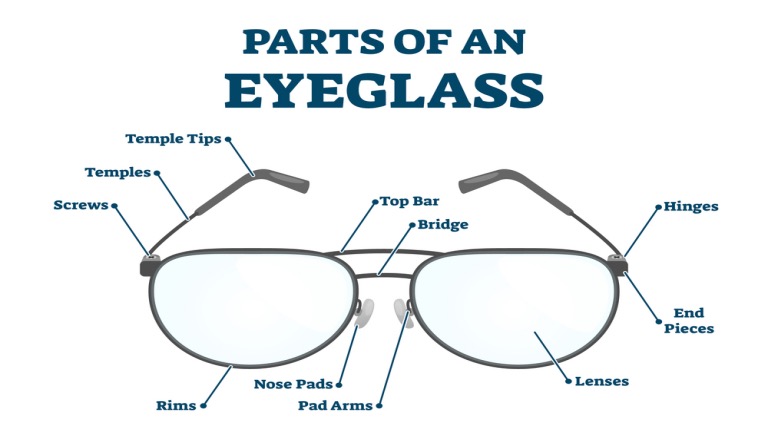While shopping for a pair of trousers or shoes, you must know what size you would need. Similarly, when selecting a pair of eyeglasses, it is advisable to do some due diligence beforehand. A perfect pair of eyeglasses would transform your overall attire. Therefore, a carefully selected one can do wonders for you. There’re various factors fit-wise to consider when looking for the perfect men’s glasses, women’s, or even children’s.
This article will provide you with all the information you need to find the best measurements for your next pair of specs, and especially nowadays with many well-known brands such as RayBan, Warby Parker, and Overnight Glasses offering a great variety of eyeglasses for everyone; it will take no time to find the perfect fit. Keep reading, and I assure you that it will be a delight for you next time you are shopping for glasses.
The Basics:
Overall an eyeglass frame has 9 parts, but there are three critical features to a glasses frame. Following are the names of these components;
- The Temple
- The Lense
- The Bridge
In general, the measurements for the width of all the components as mentioned above are taken or used in millimeters. You find these measurements printed inside the glasses frame like this xx-xxx-xx. Below is a picture that shows these components in a frame:

It is common to have a lens width for a frame of 31-60 millimeters, bridge width as 12-31 millimeters, and temple or arm length between 115-155 millimeters.
The standard sizes for arm length are 135, 140, or 145 mm. An essential feature while looking into the arm’s length of a glasses frame is making sure it sits comfortably over your ears. Sometimes when the temples are too tight on your ears, you might encounter frequent headaches.
Moving forward to the Lens width of eyesight glasses frame, it is helpful to note that your s face shape impacts this frame’s characteristic. So the first step is to find out which face shape do you have? Some of the familiar face shapes are mentioned below;
- A heart-shaped face with a narrow jawline and a large forehead.
- An oval face with a narrow jawline and narrow cheekbones.
- A circular face that has full cheeks and the forehead and jawline have similar widths.
- A square face with a solid jawline, in which the forehead and jawline are similar in width.
After identifying face type, it is time to match the lens shape with your face shape and look in the mirror. Usually, circular, heart or oval-shaped faces look better with box-type frames. Besides, square-shaped faces look trendy with both circular or oval eyesight glasses. Nevertheless, it is always up to you to choose the frame or lens you think will make you look the best. In other words, whatever floats your boat.
Last but not least is the bridge gap. It is the distance measured between two lenses. Sometimes finding a frame with a perfect bridge gap turns out to be quite a struggle. If the bridge gap is too small, it can pinch your nose and becomes a constant discomfort for you. Similarly, a glasses frame with a wide bridge will constantly keep falling from your face. Hence, you need to carefully choose a frame that perfectly suits your face and enhances your chivalry with no compromise on comfort.
Other Considerations:
Apart from the above-mentioned critical features, one should also consider measuring the frame width, lens height and width, temple arm length, and bridge gap while shopping for glasses frames.
Materials of Eyesight glasses frames:
There are a lot of materials from which the frames are fabricated these days. Each material has its pros and cons. A few such frames are mentioned below for your convenience.
-
Magnesium Frames:
These frames are durable and expensive. Magnesium frames are lighter in weight than both titanium and aluminum frames. The only drawback for these frames is their high price which is almost 1.5-2 times higher than aluminum or steel frames.
-
Beryllium Frames:
This particular type of frame is an excellent choice for hoi polloi working in saline or highly humid environments. As Beryllium is exceptionally resistant to corrosion and can withstand high temperatures, it becomes a superb choice. The only side effect is that a small percentage of people are allergic to beryllium, and they should avoid using such frames.
-
Pure Aluminium Frames:
Aluminum offers strengths of steel at half of its cost. These frames are aesthetically pleasing, lightweight, and corrosion-resistant. Another benefit is that aluminum frames are recyclable. However, in freezing climates, aluminum tends to get stiff and difficult to use.
-
Stainless steel frames:
Stainless steel has been a choice of eyewear designer for decades. Stainless steel offers corrosion resistance, durability, strength, ease of availability, and gorgeous finishing that is indeed everything an eyewear designer can wish for. Stainless steel frames are not heat resistant, though, and quite heavy as well. These couple of characteristics can be quite challenging.
-
Titanium Frames:
Titanium is found in the earth’s crust in abundance. Due to the recent industrial developments, titanium has emerged as a new alternative for aluminum and stainless steel eyeglasses frames. Titanium frames offer high-class finishing, durability, lightweight frame, and corrosion resistance.
